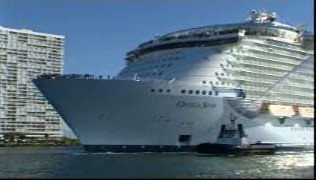
As the Caribbean grapples with its biggest decline in tourism, in sails Royal Caribbean International’s behemoth, Oasis of the Seas, with its mega proportions and economic promise. But is this a sailing knight in shining armour or just another wooden horse?
There are many who think that the Caribbean building its economy on tourism is doing so on sinking sand – literally! And that’s not just because most of the region’s hotels and resorts, from the Bahamas in the north to Tobago in the south, are built on the sea sands, much to the chagrin of environmentalists and locals who’ve lost recreational and economic access to the beach. No. There have been public and private sector officials whose unpopular view is that tourism is a fragile industry, one too affected by the vagaries of economic climate in places over which the receiving countries have no control.
The proponents of what is a multi-billion dollar industry and largest employer outside of government argue that all industries suffer from the fluctuations in the world economy and even with the crises of the latter half of the 20th Century, tourism was the fastest growing sector globally.
The financial meltdown that began in 2007/2008 has created the perfect maelstrom and opportunity for a comparison of decline and recovery matrices between the producers of visible exports, invisible exports and services.
To set the economic tone, the International Monetary Fund’s October 2009 World Economic Outlook reports: “…The decline in worker remittances and tourism earnings severely affected several economies in Central America and the Caribbean,” where real gross domestic product (GDP) – or sum of goods and services produced – moved from a growth of 5.6 per cent in 2007 to 3.0 per cent in 2008 and to a decline of -0.5 per cent in 2009.
According to World Travel and Tourism Council statistics, in 2004 the Caribbean accounted for seven per cent of world tourist arrivals, with a 7.9 per cent rise in tourist expenditure that brought in an estimated $21.6 billion. In 2005, it accounted for 15.4 per cent of GDP, 15.1 per cent of total employment and 19.7 per cent of total foreign exchange earnings.
The Bahamas, Barbados and the Caymans provide the ideal settings to study how almost wholly tourism and offshore service dependent countries of the region deal with the downturn. In 2009 for the first time the Cayman Islands’ Government had to implement taxation and seek funding from colonial mother England, who declined the request.
Among the politically independent states, the Bahamas represents the model of the old sugar or bananas monoculture that kept most of the region underdeveloped and dependent. Tourism accounts for more than 60 per cent of the country’s GDP and more than 80 per cent of visitors are from the United States.
Prime Minister Hubert Ingraham, in a mid term budget early 2009 reported “the progressive weakening in tourism activity has coincided with the deepening of the economic malaise in the United States economy… During 2008, total visitor arrivals fell by 4.6 per cent to 4.4 million relative to the same period in 2007, with the respective falloffs in air and sea traffic of 6.4 and 3.8 per cent.
“Some 1,200 jobs were eliminated in the hotel sector during 2008, and another 300 in 2009, and work weeks and work hours for many employees in the hotel sector have been reduced.”
The government of the lightly taxed country with an estimated population of 335,047 in 2008, and years of prosperity from tourism and offshore services, was planning to implement a goods and services tax and borrow $200 million to support its budget.
In an editorial August, supportive of the government’s economic austerity measures of cuts and freezes in salaries and benefits, the Tribune newspaper noted: “In the Bahamas’ financial year, 2006-2007, the (country) was running a deficit of $61 million. Last year – until the global financial crisis hit – the Bahamas had turned the corner, with a surplus of $24 million. The country’s projected figures for this financial year is an expenditure of $1.49 billion over revenue of $1.31 billion.”
Jamaica, the Dominican Republic, Belize and the Eastern Caribbean islands are good labs for observing and investigating simultaneous tourism, agricultural and industrial (including manufacturing and mining) decline and the calculus of their recovery.
While Jamaica with a 2.6 million population and a three decade economic slump boasts that it along with Cuba are the only regional destinations to have recorded increased visitor arrivals in 2009, it is seeing huge layoffs and some properties of the flagship Sandals Resorts and recent Rui constructions are being mothballed.
As if the tourism decline in earnings wasn’t enough (because of discounting to attract arrivals), the island’s bauxite/alumina industry has been virtually shut down and the administration gropes towards a billion dollar IMF balance of payments support agreement that is likely to see thousands of government job cuts in 2010 to rein in spending.
If the region is fragmented by colonial heritage and language, it is tourism that is the umbrella under which the Anglophone, Hispanic, Francophone and Dutch Caribbean stand waiting for the showers to pass. It is the only industry in which ministers of government, business leaders of resorts, travel, trade and allied services sit in council and, at least in token, agree to cooperate under the auspices of the Caribbean Tourism Organization (CTO) with similar synergies and support from the private sector-based Caribbean Hotel Association, now renamed the Caribbean Hotel and Tourism Association (CHTA).
Industry watchers will recall that these two organizations led a mid 1990s multi-million US dollar effort to market the region as a single destination as countries advertised their individual features. It was also a period of pitched battles between the land-based hoteliers and the cruise industry represented by the Florida Caribbean Cruise Association (FCCA).
Many leading hoteliers, including Sandals’ boss Gordon ‘Butch’ Stewart, and the then CHA leadership, argued for governments of the region to “level the playing field” between the cruise industry and hoteliers. The “floating hotels”, they argued, had an unfair advantage, stocking up in Florida where prices were lower than in the region and making relatively little direct financial contribution to the environment from which they benefited.
Indeed, a good example was when Dominica, acting on cue from the industry, built a deepwater port in Portsmouth, equipped with a system to provide fresh water to the ships. After spending millions in development loans, the cruise companies refused to pay user fees and threatened to drop the island from their call schedule.
And when the Organization of Eastern Caribbean States (OECS) states comprising the English-speaking Leeward and Windward Islands instituted a levy of $1.50 on all travellers to offset development cost for solid and ship-generated waste management systems, cruise companies fomented protest demonstrations by taxi drivers in some islands, telling them their governments were driving away the day visitor business.
Now things are changing. The governments are more than ever wooing the cruisers as air travel has taken a hit since September 11, 2001 – and now the financial meltdown. When the FCCA met in St Lucia early November, it issued a release quoting a study it commissioned from Business Research and Economic Advisors (BREA) that showed that FCCA-regional cruise tourism in 2008-2009 generated more than US$2.2 billion in direct expenditures, 56,000 jobs and US$720 million in employee wages among 29 destinations surveyed.
“No industry is recession-proof, but the cruise industry traditionally has been recession-resistant,” said FCCA chairman Micky Arison, chairman and CEO of Carnival Corporation & plc.
Among the BREA findings: Cruise passengers (17.56 million) spent US$1.71 billion in 29 participating destinations. An average of 52 per cent of passengers bought shore excursions, generating US$328 million in total payments to tour operators. Passengers also bought watches and jewellery ($634 million); clothing ($168 million) and other goods and services ($164 million).
The Barbados government since the 1990s had pushed itself as a home port for the start of the holiday voyages. With the November 9 inauguration of sailings to Bridgetown of TUI Cruises’ Mein Schiff, previously known as the Celebrity Galaxy, a Barbados Tourism Authority newsletter speaks of officials of the Bridgetown Port expressing their intention to implement a major redevelopment project there to enhance its home-porting prospects, “as well as to improve the overall welcome experience for cruise visitors”.
Mein Schiff is expected over the winter 2009/2010 to take 24,000 visitors to the island primarily from the German market. The vessel boasts the longest bar and the largest spa afloat, and can accommodate in excess of 2,600 passengers.
But the need for caution still resounds. Former Antigua and Barbuda diplomat and Caribbean advocate in the UK, Sir Ronald Sanders writing August on his web site about the imminent arrival of two Finnish-built mega ships (Oasis of the Seas and its sister Allure of the Seas) argued they will pose a challenge to the Caribbean’s tourism-dependent economies not only because they are too big to enter many ports or sail in their vicinity but also because they are self-contained.
Oasis, which can host 5,400 guests, will call at St Thomas US Virgin Islands, St Maarten, and the Bahamas on its Eastern Caribbean cruise, and at Haiti and Jamaica on its Western Caribbean cruise up to April 2010.
“These ships are destinations in themselves; they have more entertainment amenities including theatres, shopping, restaurants, bars, health spas, swimming pools, sports facilities than many Caribbean towns,” Sanders wrote.
“They are also a safe and secure environment. In this sense, the ships themselves are direct competition for the Caribbean destinations at which they will call.”
The hotel industry may be ailing or on slipping sand. Whether the cure will come sailing could depend on the veracity of the quote attributed to Out of Africa’s Isak Dinesen: “The cure for anything is salt water – sweat, tears, or the sea.”


About Mark Lee
Mark Lee has been a long-time journalist writing, editing and producing in print, radio television and new media.










